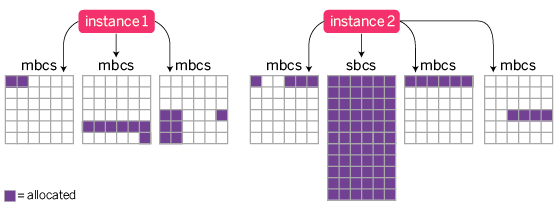Production environment-diagnose
erlang
How to diagnose problems in production environment? The answer is recon. Great tool
in production to diagnose Erlang problems.
Set the current unit to be used by recon_alloc. This effects all functions that return bytes:
recon_alloc:set_unit(X1::byte | kilobyte | megabyte | gigabyte).CPU useage top 5 processes:
recon:proc_count(reductions, 5).Memory useage top 5 processes:
recon:proc_count(memory, 5).Message queue length top 5 processes:
recon:proc_count(message_queue_len, 5).Total heap size top 5 processes:
recon:proc_count(total_heap_size, 5).Heap size top 5 processes:
recon:proc_count(heap_size, 5).Memory:
recon_alloc:memory(used).In production, if some node is long-term running, for example years, the key processes
of the node will have a big memory used, but the heap_size is small, why? Beause
there will be too many mbc(multiblock carrier), most of them is almost empty,
but not. There always be some blocks in it which have data. Like pricture below:

Normal garbage collection only remove or deallocate the block which data is useless,
but do not deallocate the mbc. The block in mbc will be reused when the size of
data fit the remainning room of the mbc. But most of the time it doesn’t fit.
So a new mbc is allocated in heap. As the node runs, more memory is allocted, but
the used is very low.
You may say “The erlang vm is suck!”. No, the designer of the Beam knew there
will be a situation like this. So they give the Beam a strategy when process do
the normal gargage collection for some times, it will do a fullsweep GC.
What is fullsweep GC? Unlike the normal GC, the fullsweep GC dealloced the mbc.
When a fullsweep GC happens, Beam will try to gather the block which contains data
to some of the mbcs as much as possible, so these mbcs is full of data, the remains
mbcs which is full of empty blocks can be deallocated. That is why after the
fullsweep GC the memory of the process reduce.
How do we controll what is the time to let the process have a fullsweep GC? When
we create a process, we use spawn_opt(Module, Function, Args, [{fullsweep_after, 10}]).
That means this process will do a fullsweep GC after it have done 10 times normal GC.
If we use spawn to create a process, the default fullsweep_after is 65535.
Have fun, guys! :)